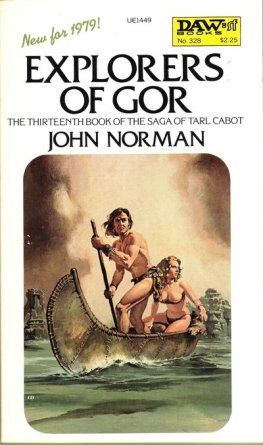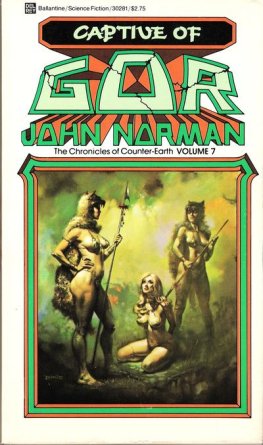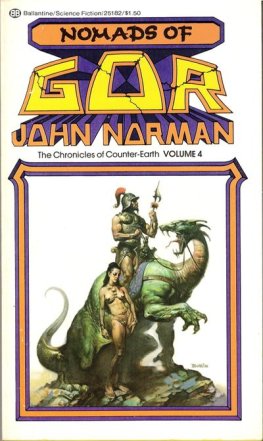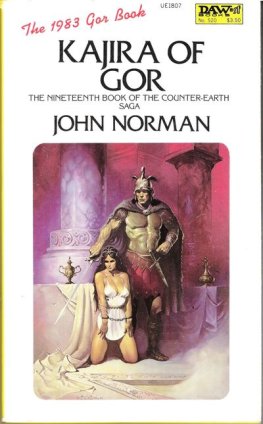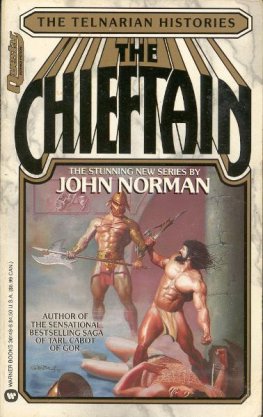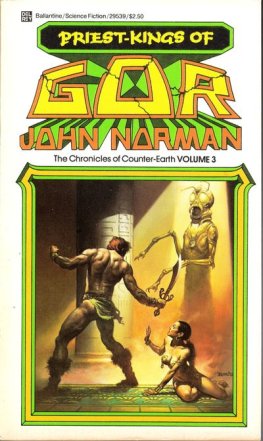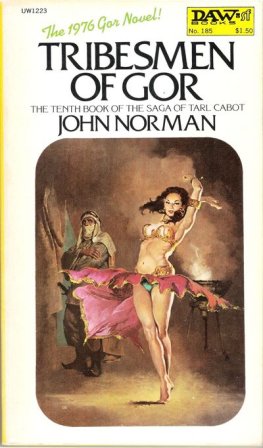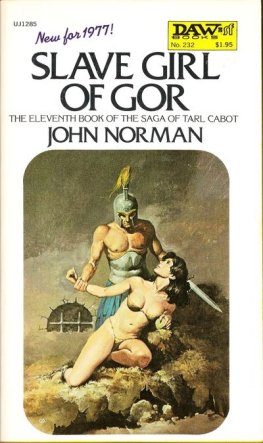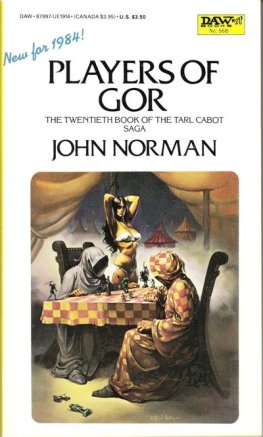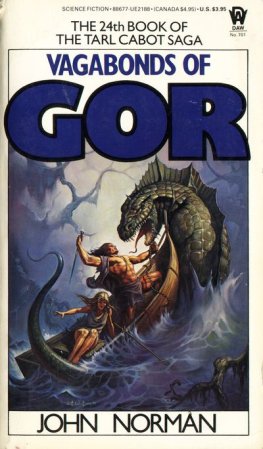EXPLORERS OF GOR
(Volume thirteen in the Chronicles of Counter-Earth)
by John Norman
She was quite beautiful.
She knelt near the small, low table, behind which, cross-legged, in the hall of Samos, I sat. At this table, too, cross-legged, sat Samos. He faced me. It was early evening in Port Kar, and I had supped with Samos, first captain in the council of captains, that congress of captains sovereign in Port Kar. The hall was lit with burning torches. It contained the great map mosaic.
We had been served our supper by the collared slave, who knelt near us.
I glanced at her. She wore a one-piece tunic of rep-cloth, cut high at the thighs, to better reveal them, her steel collar, which was a lock collar, and her brand. The brand was the common Kajira mark of Gor, the first letter, about an inch and a half in height and a half inch in width, in cursive script, of the expression Kajira, which is the most common expression in Gorean for a female slave. It is a simple mark, and rather floral, a staff, with two, upturned, frondlike curls, joined where they touch, the staff on its right. It bears a distant resemblance to the printed letter K in several of the Western alphabets of Earth, and I suspect, in spite of several differences, it may owe its origin to that letter. The Gorean alphabet has twenty-eight characters, all of which, I suspect, owe their origin to one or another of the alphabets of Earth. Several show a clear-cut resemblance to Greek letters, for example. Sidge, on the other hand, could be cuneiform, and Tun and Val are probably calligraphically drifted from demotic. At least six letters suggest influence by the classical Roman alphabet, and seven do, if we count Kef, the first letter in Kajira. Shu is represented by a sign which seems clearly oriental in origin and Homan, I speculate, may derive from Cretan. Many Gorean letters have a variety of pronunciations, depending on their linguistic context. Certain scribes have recommended adding to the Gorean alphabet new letters, to independently represent some of these sounds which, now, require alternative pronunciations, context-dependent, of given letters. Their recommendations, it seems, are unlikely to be incorporated into formal Gorean.
In matters such as those of the alphabet conservatism seems unshakable. For example, there is not likely to be additions or deletions to the alphabets of Earth, regardless of the rationality of such an alteration in given cases. An example of the conservatism in such matters is that Goreans, and, indeed, many of those of the Earth, are taught their alphabets in an order which bears no rational relation whatsoever to the occurrence pattern of the letters. That children should be taught the alphabet in an order which reflects the frequency of the occurrence of the letters in the language, and thus would expedite their learning, appears to be too radical and offensive an idea to become acceptable. Consider, too, for example, the opposition to an arithmetically convenient system of measurement in certain quarters on Earth, apparently because of the unwillingness to surrender the techniques of tradition, so painfully acquired so long ago.
Do Masters desire aught else of Linda? asked the girl.
No, said Samos.
She put her small hand on the table, as though to reach to him, to beg his touch.
No, said Samos.
She withdrew, head down. She picked up the small tray from the stand near the table. On it was the small vessel containing a thick, sweet liqueur from distant Turia, the Ar of the south, and the two tiny glasses from which we had sipped it. On the tray, too, was the metal vessel which had contained the black wine, steaming and bitter, from far Thentis, famed for its tarn flocks, the small yellow-enameled cups from which we had drunk the black wine, its spoons and sugars, a tiny bowl of mint sticks, and the softened, dampened cloths on which we had wiped our fingers.
I had eaten well.
She stood. up. She held the tray. The gleaming collar, snug and locked, was very beautiful on her throat.
I remembered her from several months ago when I had first seen her, when she had had about her throat only a simple collar of iron, curved about her throat by the blows of a metal workers hammer.
She looked at Samos, her lip trembled.
She had been the girl who had brought to the house of Samos the message of the scytale. The scytale had been a marked hair ribbon. Wrapped about the shaft of a spear, thus aligning the marks, the message had appeared. It had been to me, from Zarendargar, or Half-Ear, a war general of the Kurii, inviting me to meet him at the worlds end. My speculation that this referred to the pole of the Gorean northern hemisphere had proved correct. I had met Half-Ear there, in a vast northern complex, an enormous supply depot intended to arm and fuel, and otherwise logistically support, the projected invasion of Gor, the Counter-Earth. I think it likely that Half-Ear perished in the destruction of the complex. The body, however, was never recovered.
The girl who had served us this night, slender and blond, blue-eyed, of Earth origin, had delivered to us the scytale. She had not, originally, even understood it to contain a message.
How different she seemed now from what she had then been. She had been brought to the house of Samos still in the inexplicable and barbarous garments of Earth, in particular, in the imitation-boy costume, the denim trousers and flannel shirt of the contemporary Earth girl, pathologically conditioned, for economic and historical reasons, to deny and subvert the richness of her unique sexuality. Culture decides what is truth, but truth, unfortunately for culture, is unaware of this. Cultures, mad and blind, can die upon the rocks of truth. Why can truth not be the foundation of culture, rather than its nemesis? Can one not build upon the stone cliffs of reality rather than dash ones head against them? But how few human beings can think, how few dare to inquire, how few can honestly question. How can one know the answer to a question which one fears to ask?
Samos, of course, immediately recognized the ribbon as a scytale. As for the girl, he had promptly, to her horror, had her clothing removed and had had her put in a brief rep-cloth slave tunic and a rude neck-ring of curved iron, that she would not escape and, anywhere, could be recognized as a slave. Shortly thereafter I had been invited to his house and had received the message. I had also questioned the girl, who had, at that time, spoken only English. I recalled how arrogant and peremptory she had been, until she had learned that she was no longer among men such as those of Earth. Samos had had her taken below and branded, and used for the sport of the guards, and then penned. I had thought that he would have sold her, but he had not. She had been kept in his own house, and taught the meaning of her collar, fully.
I saw the brand on her thigh. Although the brand was the first letter, in cursive Gorean script, of the most common Gorean expression for a slave girl, Kajira, its symbolism, I think, is much richer than this. For example, in the slave brand, the Kef, though clearly a Kef and in cursive script, is more floral, in the extended, upturned, frondlike curls, than would be the common cursive Kef. This tends to make the mark very feminine. It is at this point that the symbolism of the brand becomes more clear. The two frondlike curls indicate femininity and beauty; the staff, in its uncompromising severity, indicates that the femininity is subject to discipline; the upturned curves on the frondlike curls indicate total openness and vulnerability. It is a very simple, lovely brand, simple, as befits a slave, lovely, as befits a woman.
Incidentally, there are many brands on Gor. Two that almost never occur on Gor, by the way, are those of the moons and collar, and of the chain and claw. The first of these commonly occurs in certain of the Gorean enclaves on Earth, which serve as headquarters for agents of Priest-Kings; the second tends to occur in the lairs of Kurii agents on Earth; the first brand consists of a locked collar and, ascending diagonally above it, extending to the right, three quarter moons; this brand indicates the girl is subject to Gorean discipline; the chain-and-claw brand signifies, of course, slavery and subjection within the compass of the Kur yoke. It is apparently difficult to recruit Goreans for service on Earth, either for Priest-Kings or Kurii. Accordingly, usually native Earthlings are used. Glandularly sufficient men, strong, lustful, and vital, without their slave girls, would find Earth a very dismal place, a miserable and unhappy sexual desert. Strong men simply need women. This will never be understood by weak men. A strong man needs a woman at his feet, who is truly his. Anything else is less than his fulfillment. When a man has once eaten of the meat of gods he will never again chew on the straw of fools.

